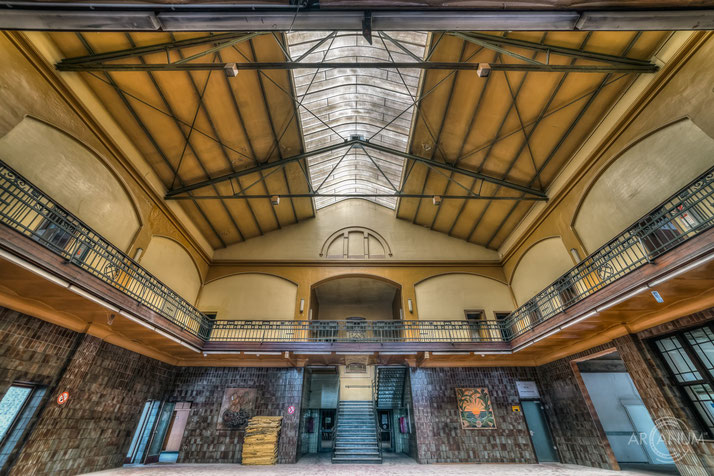Colliery H.
The Heinrich-Robert colliery, founded in 1901 as de Wendel colliery, was the last producing coal mine in the city of Hamm and, together with Aden/Monopol Kamen colliery, was part of the Bergwerk Ost group. The colliery was finally closed in 2010. For a long time, the colliery was called de Wendel. This is directly linked to the origins of the financiers, a large industrial family from Lorraine who had been involved in the steel industry since the early 18th century. They operated the steelworks in Hayange, which today belong to Arcelor, for almost three centuries.
The namesakes were Henri (Heinrich) and Robert de Wendel, after whom shafts 1 and 2 were named. Mine pioneer Heinrich Grimberg had already dug the mine fields in 1874 and sold them in 1900. There was a shortage of fat coal in the Saar area in germany, and it was intended to supply the smelting works operated there. The coke produced in the Saar region was of inferior quality. The situation was similar in the neighboring mines that supplied other companies - Saxony (Saxony/Saxony-Anhalt) and Westphalia (Aachen coalfield).
The company was renamed Heinrich Robert in 1937. In 1978, the field was connected to the closed Werne colliery in order to mine the economically viable remaining reserves. In 1988, the "Bergwerk Ost" (Colliery East) was established after the remaining fields of the decommissioned neighboring facilities were incorporated. It handled the controlled dismantling of the operating facilities and of the 14 shafts taken over, only three remained in long-term use. They were mainly used for water conservation. The entire operation ended in 2010. Coal was mined mainly in the mine's own mine field, which obviously had a very large coal reserve.
During the 1st and 2nd World Wars, the mine was under German receivership and then returned to its owners. It developed significantly better than the neighboring mines (probably due to the secure sale of coal and coke).
Accidents also occurred here due to the high methane content in the coal, but somewhat later than at the neighboring mines. In 1926, eleven miners died in a firedamp explosion. Despite the sinking of the necessary ventilation shafts, there were four fatalities in another explosion in 1927 and another 17 in the last explosion in 1951. This meant that operations were relatively safe overall.
The year 1969 marked a fundamental change in coal mining at Heinrich Robert colliery. The founding family de Wendel sold the colliery to Ruhrkohle AG. This meant, among other things, that the colliery was able to expand as the previous production limit of 1.5 million tons was lifted; for the first time, the colliery was able to expand beyond its own limited mine area, which was only around 18 km² in size. This was a late development, as the mine fields of the neighboring Sachsen colliery had already reached an area of around 100 km² by 1954.
By 1990, Heinrich-Roberts Grubenfeld had reached a size of 37 km²; the workforce consisted of 5,326 men and produced 3,336,924 tons per year. This record figure was followed in 1994 by a restriction of the daily output to 9,000 tons by RAG, which resulted in the closure of the opencast facilities at Franz shaft. It was put back into operation a year later for rope access. Another milestone in the history of mining was also reached in 1994 with the breakthrough of the seventh level of the Sandbochun shaft.
On November 10, 1997, the plans for the Verbundbergwerk Ost were presented to the public: Heinrich-Robert was to enter into an association with the Haus Aden/Monopol mine in Bergkamen; Heinrich-Robert was to be the extraction site. The joint output was to be reduced from around 10,000 tons each to a total of 15,000 tons. It was also decided to gradually reduce the workforce. Heinrich-Robert had already reduced its workforce in advance to 3,217 employees; together the two mines had around 6,800 employees, of which only 3,500 were to remain by the year 2000. The plan envisaged the retention of only seven of the 17 shafts; the others were to be dismantled.
The last production shift was worked on September 30, 2010. Since then, mining in the eastern Ruhr area has also been at a standstill. One year later, all machinery and equipment had been dismantled underground.
As part of the discussions surrounding the subsequent use of the Ost colliery site, the city of Hamm adopted a plan to build the Heinrich-Robert creative district at the end of 2016. According to these plans, the colliery site is to be redeveloped with a mix of residential buildings, retail and commercial space once the soil remediation has been completed and the mine has been released from mining supervision.
Sources: Wikipedia, Ruhrzechenhaus.de
Visited: August 3, 2020 - LEGAL VISIT, PHOTOS TAKEN WITH PERMISSION
Location: Hamm, Germany
Status: in development/reused





































































